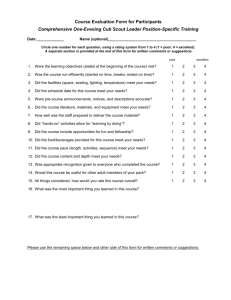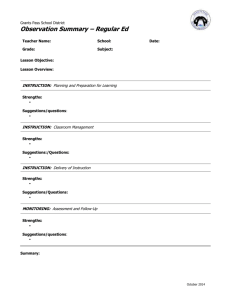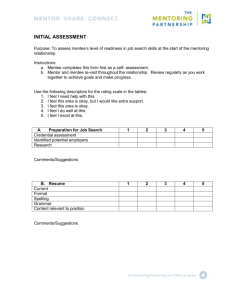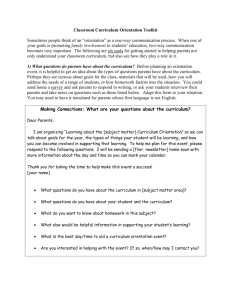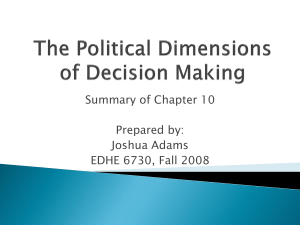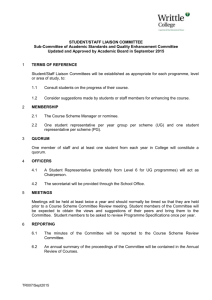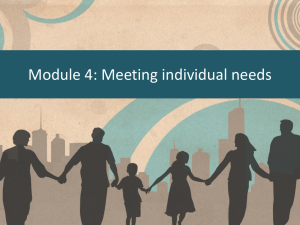LLI lesson formats & writing formats
advertisement
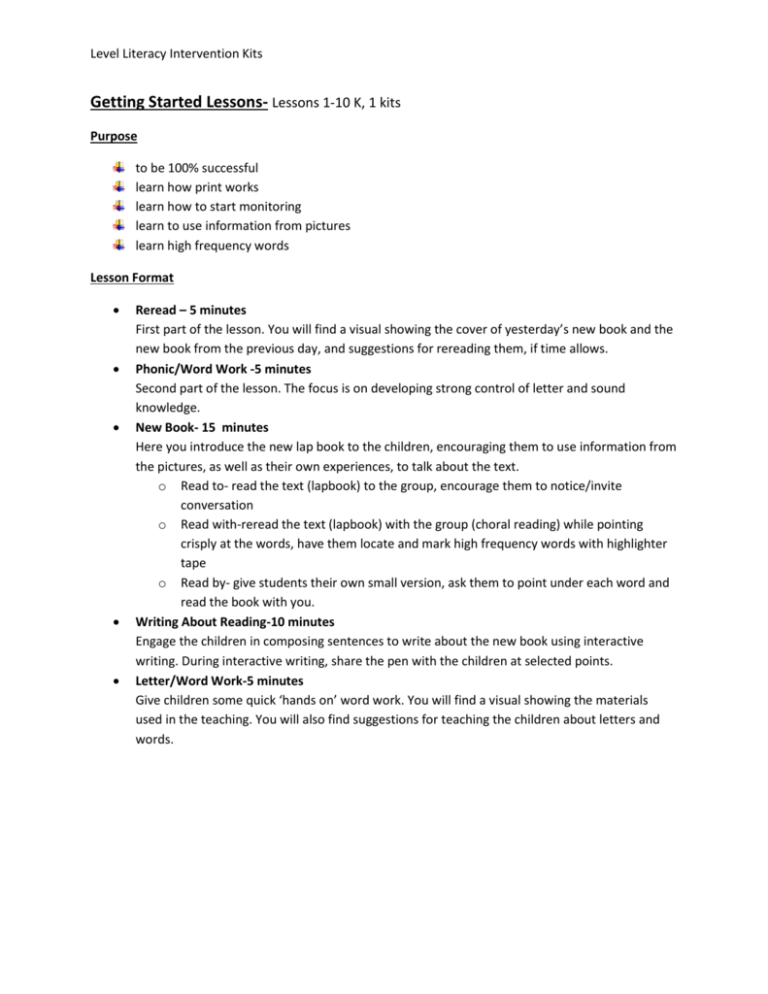
Level Literacy Intervention Kits Getting Started Lessons- Lessons 1-10 K, 1 kits Purpose to be 100% successful learn how print works learn how to start monitoring learn to use information from pictures learn high frequency words Lesson Format Reread – 5 minutes First part of the lesson. You will find a visual showing the cover of yesterday’s new book and the new book from the previous day, and suggestions for rereading them, if time allows. Phonic/Word Work -5 minutes Second part of the lesson. The focus is on developing strong control of letter and sound knowledge. New Book- 15 minutes Here you introduce the new lap book to the children, encouraging them to use information from the pictures, as well as their own experiences, to talk about the text. o Read to- read the text (lapbook) to the group, encourage them to notice/invite conversation o Read with-reread the text (lapbook) with the group (choral reading) while pointing crisply at the words, have them locate and mark high frequency words with highlighter tape o Read by- give students their own small version, ask them to point under each word and read the book with you. Writing About Reading-10 minutes Engage the children in composing sentences to write about the new book using interactive writing. During interactive writing, share the pen with the children at selected points. Letter/Word Work-5 minutes Give children some quick ‘hands on’ word work. You will find a visual showing the materials used in the teaching. You will also find suggestions for teaching the children about letters and words. Level Literacy Intervention Kits Odd Day LessonsReread-5 minutes First part of the lesson. You will find a visual showing yesterday’s new book and the new book from the previous day, suggestions for rereading them, if time allows Phonics/Word Work-5 minutes Second part of the lesson. The focus is developing strong control of letter/sound knowledge. New Book- 15 minutes Third part of the lesson. Provides instructions for teaching using the new book. o o o o Introducing the text- gives you suggestions to scaffold the child’s use of the meaning, language, and visual information in print. Reading the Text -provides suggestions for using the Prompting Guide to supports the childrens’ effective problem-solving strategies as they read the text. Discussing & Revising the Text- Suggestions for having a comprehension conversation with the children and key understanding about the text. Teaching Points- Based on your observations, you select key teaching the children need. You will use Prompting Guide 1 to teach for, prompt for, or reinforce effective behavior. Letter/Word Work-5 minutes Fourth part of the lesson. Her you guide children in some quick ‘hands on’ word work. You will find a visual showing the materials used in the teaching. You will also find suggestions for teaching the children about letters and words. Level Literacy Intervention Kits Even Day LessonsReread/Assessment- 5 minutes First part of the lesson. You will find a list & suggestions for rereading yesterday’s new books and the book from the previous day. As children softly reread the previous dya’s new book, listen to one child read yesterday’s new book, code the child’s oral reading on the corresponding Recording Form, have a brief comprehension conversation, and make a teaching point that will be most helpful to the reader. Phonics/Word Work- 5 minutes Second part of the lesson. You will engage children in learning a phonics principle. The focus is on developing strong control of letter & sound knowledge. Writing About Reading- 10 minutes Third part of the lesson. You will find one of three types of writing to use with the children: Interactive Writing, Dictated Writing, or Independent Writing. New Book- 10 minutes Fourth part of the lesson in which you will introduce the new book. The book is usually one or two levels below the level of the new book in the odd- numbered lesson. You will find specific instructions for teaching using the new book. o o o o Introducing the text-Specific suggestions to scaffold the child’s use of the meaning, language, and visual information in print. Reading the Text- Suggestions for using the Fountas & Pinnell Prompting Guide 1 to support children’s effective problem-solving strategies as they read the text. Discussing & Revisiting the Text- Suggestions for having a comprehension conversation with the children & key understandings about the text. Teaching Points- Based on your observations, select key teaching the children need. Use the Prompting Guide to teach for, prompt for, or reinforce effective behavior. We provide some suggestions for you to consider. Letter/Word Work (optional) Suggestions for word work with letters and words if time allows. Level Literacy Intervention Kits Writing About ReadingPurpose- Writing extends children’s comprehension and helps them become a writer. It extends conversation about texts Tools-marker, writing book, white tape, chart paper (unlined), prompting guide Interactive- write together Shared-teacher writes children compose Purpose- duplicates every aspect of the writing process in a highly supported way. Chart paper with no lines Always spelled correctly Reread after writing You want it to look like a book-use black marker Dictated Purpose- children learn how to go from oral to written language & experience word solving within a meaningful sentence. Teaching piece NOT assessment Read aloud a sentence & children write it in their writing books with your support. Help children write in conventional form as it becomes a text for reading. As needed, model word construction using a whiteboard or prompting for letter formation. Use white correction tape as needed Independent Purpose-children develop control of early writing strategies. They learn to represent ideas in different ways and to self-monitor with writing. Children write their own texts with support All writing in conventional form. Use white correction tape to assist children to cover mismatches quickly & make the text readable. You do not want cross-outs and you do not want children to spend time erasing Level Literacy Intervention Kits
